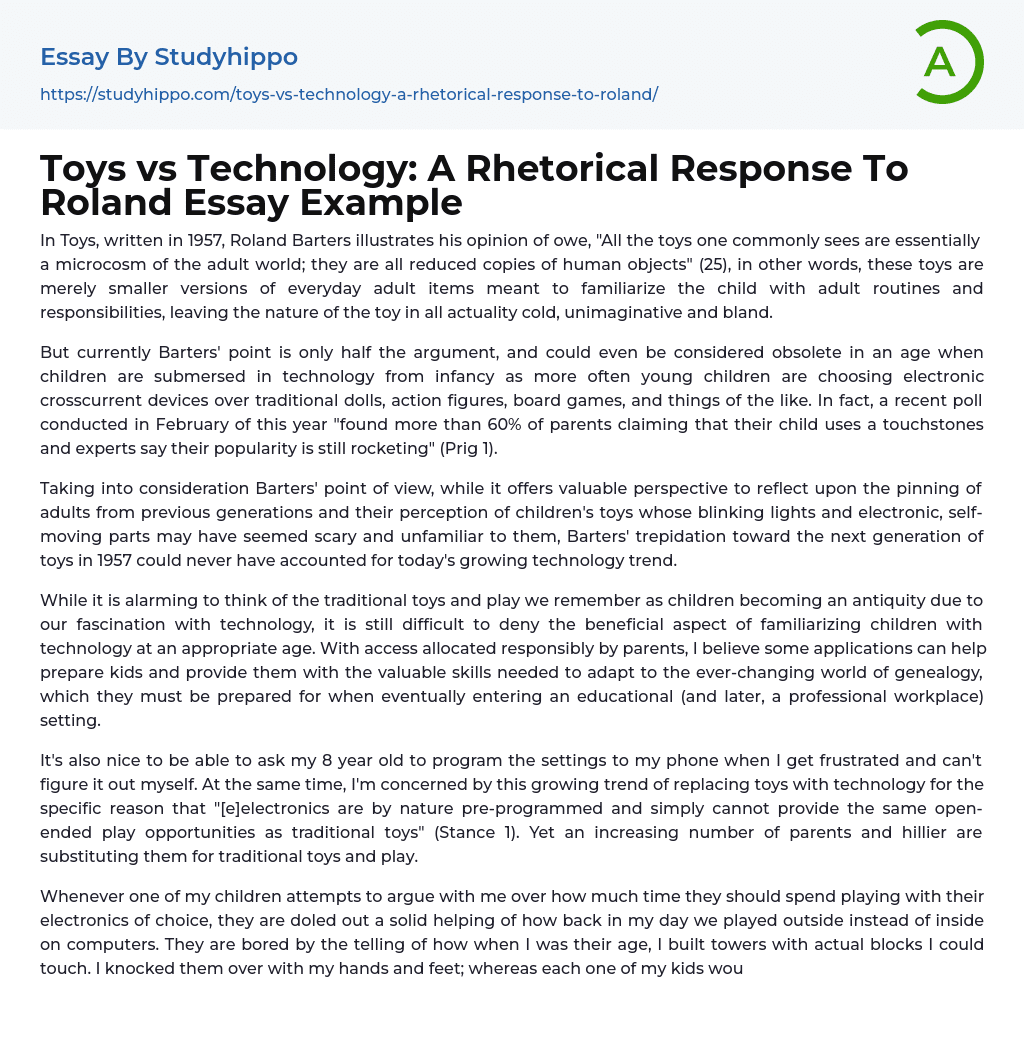

Toys vs Technology: A Rhetorical Response To Roland Essay Example
In his 1957 work "Toys," Roland Barters expresses the idea that toys are essentially miniatures of objects found in the adult world, serving to familiarize children with adult routines and responsibilities. He suggests that such toys are cold, unimaginative, and bland (25). However, this perspective is now only part of the argument, as children today are increasingly engaging with electronic devices from a young age. A recent poll conducted in February found that over 60% of parents reported their child using touchscreen devices, which are still growing in popularity (Prig 1). While Barters' viewpoint provides valuable insight into previous generations' perceptions of children's toys, it fails to account for the current surge in technological toys that would have been unfamiliar and potentially unsettling to him in 1957.
Although it may cause concern to see traditional toys and play becom
...ing obsolete due to our fascination with technology, it is undeniable that familiarizing children with technology at the appropriate age can be beneficial. As long as parents allocate access responsibly, certain applications can help children develop valuable skills necessary for navigating the constantly evolving world. This is crucial for their educational and professional future.
Additionally, it is convenient to have my 8-year-old assist me in programming my phone when I struggle with it. However, there is a growing concern that toys are being replaced by technology. This is because electronics lack the open-ended play opportunities that traditional toys offer (Stance 1). Despite this concern, more and more parents and caregivers are substituting traditional toys and play with technology.
Whenever my children argue about the amount of time they should spend on their preferred electronic
devices, I remind them of how we used to play outside or build towers with physical blocks when I was their age.I used my hands and feet to knock them over, whereas my kids prefer to throw angry electronic birds at blocks on a screen. These popular electronic games, such as Angry Birds and Mineshaft, offer some creativity, but they cannot provide the physical and tangible experience of building a structure block by block. This process of trial and error and the subsequent excitement of knocking it down cannot be duplicated by electronic games or touchstone applications. Furthermore, these games cannot offer the diversity of play that allows a child to imagine different scenarios, like playing knights with a friend using the blocks as bricks of gold. Electronic games and touchstone applications lack the person-to-person interaction that is important for a child's development.
As parents, it is our duty to safeguard traditional play, limit our children's use of electronics during playtime, and educate ourselves about the unique developmental benefits provided by traditional play. According to Michael Riyal, MD on his website, Parenting 101, engaging in traditional games and play helps children acknowledge and manage their emotions, including dealing with frustration, excitement, anger, and anxiety. It also teaches them how to communicate courteously with other players (1).
I firmly believe that these essential interactions play a crucial role in a child's social development, which cannot be fully experienced through electronic games and digital applications. As Barters suggests, toys always hold social significance and are shaped by the myths and practices of contemporary adult life (27). Therefore, as parents, we have a responsibility to carefully
evaluate whether the technological aspects of adult life form an appropriate substitute for traditional toys and play. Furthermore, we must consider the impact on future generations if they never have the chance to play with toys or interact with each other.
- Single Parent essays
- Single Parenting essays
- Electronics essays
- Computer Science essays
- Consumer Electronics essays
- Enterprise Technology essays
- Hardware essays
- Robot essays
- engineering essays
- people search essays
- Modern Technology essays
- Impact of Technology essays
- Cloud Computing essays
- Operating Systems essays
- Information Technology essays
- Data Analysis essays
- Information Age essays
- Smartphone essays
- Cell Phones essays
- Camera essays
- Computer essays
- Ipod essays
- Mobile Phones essays
- 3g essays
- Bluetooth essays
- Cell Phones in School essays
- Computer File essays
- Desktop Computer essays
- Servers essays
- Data collection essays
- Graphic Design essays
- Data Mining essays
- Cryptography essays
- Internet essays
- Network Security essays
- Android essays
- Computer Security essays
- World Wide Web essays
- Website essays
- Computer Network essays
- Application Software essays
- Computer Programming essays
- Computer Software essays
- Benchmark essays
- Information Systems essays
- Email essays
- Hypertext Transfer Protocol essays
- Marshall Mcluhan essays
- Virtual Learning Environment essays
- Web Search essays



